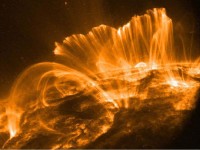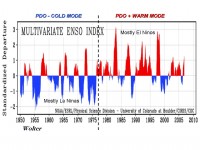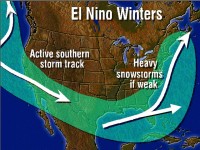By Roger Pielke Sr. Climate Science Blog
In the final blog on Climate Science (we will miss your insightful blogs, Roger), Roger summarizes the conclusions he has formed on Climate Science. Here are a few of them. See all of them here.
In terms of climate change and variability on the regional and local scale, the IPCC Reports, the CCSP Report on surface and tropospheric temperature trends, and the U.S. National Assessment have overstated the role of the radiative effect of the anthropogenic increase of CO2 relative to the role of the diversity of other human climate climate forcing on global warming, and more generally, on climate variability and change. Global and regional climate models have not demonstrated skill at predicting regional and local climate change and variability on multi-decadal time scales. Attempts to significantly influence regional and local-scale climate based on controlling CO2 emissions alone is an inadequate policy for this purpose.
Humans are significantly altering the global climate, but in a variety of diverse ways beyond the radiative effect of carbon dioxide. The IPCC assessments have been too conservative in recognizing the importance of these human climate forcings as they alter regional and global climate. These assessments have also not communicated the inability of the models to accurately forecast the spread of possibilities of future climate. The forecasts, therefore, do not provide any skill in quantifying the impact of different mitigation strategies on the actual climate response that would occur.
By Syun-ichi Akasofu Commentary in the Wall Street Journal
Climate change reared its head again last week at the Asia-Pacific Economic Cooperation summit in Sydney, where participating heads of state struggled to reach a consensus on how to reduce emissions of carbon dioxide (CO2). The political squabbling, global warming true believers will say, stands in stark contrast to the scientific consensus that the greenhouse effect, a product of increasing CO2 in the atmosphere, is causing dramatic climate change. There’s just one problem with this view: There’s a lot less to that “scientific consensus” than meets the eye.
Scientists have no clear knowledge of the cause of the Little Ice Age and of the subsequent rebound; or of the Big Ice Age; or of a warm period when the Arctic Ocean had no ice; or of the medieval warming period. In fact, IPCC scientists do not understand the causes of the rapid increase of temperature from 1910 to 1945; or the decrease from 1945 to 1975, when CO2 levels were rising. Without understanding these recent changes, it is premature for the IPCC to jump to the conclusion that CO2 is the main cause of the last 30 years of global warming.
Many people claim scientists proved the greenhouse effect with models run on supercomputers. But a supercomputer is not a crystal ball. Scientists merely enter observed (or expected) CO2 amounts into a computer and, using an algorithm, a projection emerges. No computer can accurately represent such a gigantic system as the Earth with all its unknown processes, such as the causes of the medieval warm period and the Little Ice Age. Therefore, no supercomputer, no matter how powerful, is able to prove definitively a simplistic hypothesis that says the greenhouse effect is responsible for warming. Read full commentary here. Read more on why supercomputers can’t be relied on here.
By Lance Endersbee
The Earth, the Sun, and indeed the Cosmos, comprise an inter-acting, dynamic, and evolving system. It is all in a state of continuing change. There is no steady state. In contrast, the IPCC assumes that the Earth was in a steady state until 250 years ago, which was upset by Man through increasing use of carbon fuels, and that led to atmospheric changes and consequential global warming.

The Sun is the dominating influence on the climate of the Earth. That simple fact is not recognised by IPCC. The Sun is a churning, quivering body of hot plasma, generating intense electromagnetic fields in space that envelop the Earth. The electromagnetic behaviour of the Sun dominates and determines the electromagnetic and geotectonic response of the Earth, and thereby climate.
A key part of the IPCC report is the presentation of evidence of parallel increases in both global temperatures and levels of carbon dioxide in the atmosphere. It is claimed by IPCC that the increased carbon dioxide emitted by Man is causing global warming. In my paper it is shown that the cause and effect relation is exactly the opposite; that natural global warming has caused an increase in the level of carbon dioxide in the atmosphere, simply because of the reduction in solubility of carbon dioxide in sea water with increasing sea temperatures. See image here. See full paper here. See also a WORD document letter explaining the paper here.
National Review Online, September 4, 2007
Bjorn Lomborg is back, and his critics will not be happy. In 2001, the Danish statistician published The Skeptical Environmentalist, an optimistic assessment of global environmental trends that provoked intense controversy and debate. His data-driven challenge to the “Litany” of environmental pessimism incited vitriolic attacks from environmentalist doomsayers. Malthusian environmental activists sought to discount his message, accusing Lomborg of “scientific dishonesty” and, in one case, throwing a pie in his face. Such tactics failed to accomplish anything but increase Lomborg’s notoriety and boost book sales.
If The Skeptical Environmentalist gave eco-pessimists epileptic fits, Lomborg’s new book could provoke outright seizures. Cool It: The Skeptical Environmentalist’s Guide to Global Warming is Lomborg’s take on the number one environmental issue of the day. Lomborg remains stubbornly optimistic about humanity’s future as he argues we must “cool our conversation, rein in the exaggerations, and start focusing where we can do the most good.” For Lomborg, this also means cooling the push for binding limits on greenhouse-gas emissions.
At times Lomborg’s discussion seems a bit technocratic, and he understates the degree of uncertainty inherent in climate-change policy. Estimates of future emissions and energy use patterns decades hence are highly suspect. So too are climate projections that are based on such uncertain inputs. This does not mean that climate-change concerns should be dismissed, but it does counsel against pretending cost-benefit analyses can be conducted with any degree of precision. Despite these flaws, Cool It is a highly valuable contribution to the climate-policy literature. In clear and concise prose, Lomborg diagnoses the problems plaguing contemporary climate policy, injecting a needed tonic of realism and common sense into the climate debate. And for that very reason, it is sure to make Lomborg’s critics hot-under-the-collar.
Read more here.
By Gary Sharp, Scientific Director, Center for Climate/Ocean Resources Study
Read in this blog, the thoughts from Gary Sharp on the Arctic passage. We posted a recent story about Wrong Way Flanagan getting trapped in the arctic ice during an effort to be the first yachtsman to traverse the arctic in modern times to illustrate global warming. Although there will be stories about the melting of ice in the western arctic in the news, Gary discusses why this is not unusual historically. You will find some of his links fascinating and his stories about Joseph Fletcher inspiring. We hope to link to some of the videos and lectures of Dr. Fletcher on Icecap. See also Gary’s website Its All About Time here.
About arctic passages Gary notes “Joe pointed out several times to me in his B/W movies that there were seasons of nearshore ice-free situations - and others when skis or overflights were the only way in or out. Unfortunately - not enough years of observations - or guys with the right questions out there. Between 1956 and 1989 there were 33 passages. They are listed in the book Northwest Passage by Edward Struzik published in 1991. One was by K. Horie aboard the Japanese sloop Mermaid, who made an east to west passage in 1981-83. Another was by W. De Roos in a 42 foot ketch named Williwaw, who made the first single handed Passage in 1977 when the Northern Hemisphere was rather cold. Then, of course, there were all those US and Russian submarines cruising under the polar ice in the late 1950-90 Cold War period – that would occasionally find a hole – and pop up for a look-see.”
By Kevin Vranes
Changnon’s new paper has the following in the abstract: “Winter storms are a major weather problem in the USA and their losses have been rapidly increasing. A total of 202 catastrophic winter storms, each causing more than $1 million in damages, occurred during 1949–2003, and their losses totaled $35.2 billion (2003 dollars). Catastrophic winter storms occurred in most parts of the contiguous USA, but were concentrated in the eastern half of the nation where 88% of all storm losses occurred.
The time distribution of the nation’s 202 storms during 1949–2003 had a sizable downward trend, whereas the nation’s storm losses had a major upward trend for the 55-year period. This increase over time in losses, given the decrease in storm incidences, was a result of significant temporal increases in storm sizes and storm intensities. Increases in storm intensities were small in the northern sections of the nation, but doubled across the southern two-thirds of the nation, reflecting a climatic shift in conditions producing intense winter storms.
Icecap Note: What was that climate shift? After the Great Pacific Climate Shift in 1979, the frequency of El Ninos increased dramatically, with incidences nearly double those of La Ninas. El Ninos favor a southern storm track in winter, La Nina storms ride across the north. Wolter’s MEI Index are shown below from 1950 to 2006. Note red spikes are El Ninos, blue La Ninas. Note the increase in El Ninos after 1979.


During El Ninos, southern storm tracks are favored in winter
By Alan Caruba on Sep 02, 07
When did the global warming hoax die? Historians are likely to pinpoint 2007. It will take another decade to insure it cannot be revived, but the avalanche of scientific studies and the cumulative impact of scientists who have publicly joined those who debunked the lies on which it has been based will be noted as the tipping point.
It took some forty years to unmask the Piltdown Man hoax that began in 1912 alleging that the skull of an ancient ancestor of man had been found in England. Any number of British anthropologists unwittingly contributed to the hoax by confirming the authenticity of the skull until it was found that the jaw of an orangutan had been cunningly attached. The unmasking of “global warming” has taken less than half that time.
Hoaxes have a life of their own and “global warming” is now coming to an end. Mark 2007 as the year it began to seriously bleed to death. Read reasons why here.
By Lawrence Solomon, Financial Post
We are doomed, say climate change scientists associated with the United Nations Intergovernmental Panel on Climate Change, the United Nations body that is organizing most of the climate change research occurring in the world today. Carbon dioxide from man-made sources rises to the atmosphere and then stays there for 50, 100, or even 200 years. This unprecedented buildup of CO2 then traps heat that would otherwise escape our atmosphere, threatening us all.
“This is nonsense,” says Tom V. Segalstad, head of the Geological Museum at the University of Oslo and formerly an expert reviewer with the same IPCC. He laments the paucity of geologic knowledge among IPCC scientists—a knowledge that is central to understanding climate change, in his view, since geologic processes ultimately determine the level of atmospheric CO2.
“The IPCC needs a lesson in geology to avoid making fundamental mistakes,” he says. “Most leading geologists, throughout the world, know that the IPCC’s view of Earth processes are implausible if not impossible.”
Catastrophic theories of climate change depend on carbon dioxide staying in the atmosphere for long periods of time—otherwise, the CO2 enveloping the globe wouldn’t be dense enough to keep the heat in. Until recently, the world of science was near-unanimous that CO2 couldn’t stay in the atmosphere for more than about five to 10 years because of the oceans’ near-limitless ability to absorb CO2.
Amazingly, the hypothetical results from climate models have trumped the real world measurements of carbon dioxide’s longevity in the atmosphere. Those who claim that CO2 lasts decades or centuries have no such measurements or other physical evidence to support their claims. Neither can they demonstrate that the various forms of measurement are erroneous.
“They don’t even try,” says Prof. Segalstad. “They simply dismiss evidence that is, for all intents and purposes, irrefutable. Instead, they substitute their faith, constructing a kind of science fiction or fantasy world in the process.”
Read full story here.




